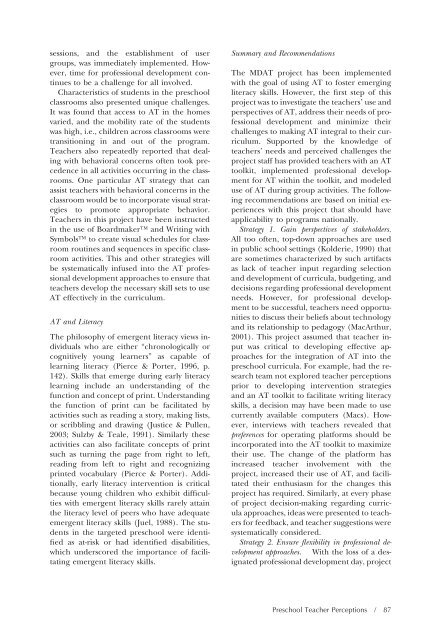Download the Journal (PDF) - Division on Autism and ...
Download the Journal (PDF) - Division on Autism and ...
Download the Journal (PDF) - Division on Autism and ...
You also want an ePaper? Increase the reach of your titles
YUMPU automatically turns print PDFs into web optimized ePapers that Google loves.
sessi<strong>on</strong>s, <strong>and</strong> <str<strong>on</strong>g>the</str<strong>on</strong>g> establishment of user<br />
groups, was immediately implemented. However,<br />
time for professi<strong>on</strong>al development c<strong>on</strong>tinues<br />
to be a challenge for all involved.<br />
Characteristics of students in <str<strong>on</strong>g>the</str<strong>on</strong>g> preschool<br />
classrooms also presented unique challenges.<br />
It was found that access to AT in <str<strong>on</strong>g>the</str<strong>on</strong>g> homes<br />
varied, <strong>and</strong> <str<strong>on</strong>g>the</str<strong>on</strong>g> mobility rate of <str<strong>on</strong>g>the</str<strong>on</strong>g> students<br />
was high, i.e., children across classrooms were<br />
transiti<strong>on</strong>ing in <strong>and</strong> out of <str<strong>on</strong>g>the</str<strong>on</strong>g> program.<br />
Teachers also repeatedly reported that dealing<br />
with behavioral c<strong>on</strong>cerns often took precedence<br />
in all activities occurring in <str<strong>on</strong>g>the</str<strong>on</strong>g> classrooms.<br />
One particular AT strategy that can<br />
assist teachers with behavioral c<strong>on</strong>cerns in <str<strong>on</strong>g>the</str<strong>on</strong>g><br />
classroom would be to incorporate visual strategies<br />
to promote appropriate behavior.<br />
Teachers in this project have been instructed<br />
in <str<strong>on</strong>g>the</str<strong>on</strong>g> use of Boardmaker <strong>and</strong> Writing with<br />
Symbols to create visual schedules for classroom<br />
routines <strong>and</strong> sequences in specific classroom<br />
activities. This <strong>and</strong> o<str<strong>on</strong>g>the</str<strong>on</strong>g>r strategies will<br />
be systematically infused into <str<strong>on</strong>g>the</str<strong>on</strong>g> AT professi<strong>on</strong>al<br />
development approaches to ensure that<br />
teachers develop <str<strong>on</strong>g>the</str<strong>on</strong>g> necessary skill sets to use<br />
AT effectively in <str<strong>on</strong>g>the</str<strong>on</strong>g> curriculum.<br />
AT <strong>and</strong> Literacy<br />
The philosophy of emergent literacy views individuals<br />
who are ei<str<strong>on</strong>g>the</str<strong>on</strong>g>r “chr<strong>on</strong>ologically or<br />
cognitively young learners” as capable of<br />
learning literacy (Pierce & Porter, 1996, p.<br />
142). Skills that emerge during early literacy<br />
learning include an underst<strong>and</strong>ing of <str<strong>on</strong>g>the</str<strong>on</strong>g><br />
functi<strong>on</strong> <strong>and</strong> c<strong>on</strong>cept of print. Underst<strong>and</strong>ing<br />
<str<strong>on</strong>g>the</str<strong>on</strong>g> functi<strong>on</strong> of print can be facilitated by<br />
activities such as reading a story, making lists,<br />
or scribbling <strong>and</strong> drawing (Justice & Pullen,<br />
2003; Sulzby & Teale, 1991). Similarly <str<strong>on</strong>g>the</str<strong>on</strong>g>se<br />
activities can also facilitate c<strong>on</strong>cepts of print<br />
such as turning <str<strong>on</strong>g>the</str<strong>on</strong>g> page from right to left,<br />
reading from left to right <strong>and</strong> recognizing<br />
printed vocabulary (Pierce & Porter). Additi<strong>on</strong>ally,<br />
early literacy interventi<strong>on</strong> is critical<br />
because young children who exhibit difficulties<br />
with emergent literacy skills rarely attain<br />
<str<strong>on</strong>g>the</str<strong>on</strong>g> literacy level of peers who have adequate<br />
emergent literacy skills (Juel, 1988). The students<br />
in <str<strong>on</strong>g>the</str<strong>on</strong>g> targeted preschool were identified<br />
as at-risk or had identified disabilities,<br />
which underscored <str<strong>on</strong>g>the</str<strong>on</strong>g> importance of facilitating<br />
emergent literacy skills.<br />
Summary <strong>and</strong> Recommendati<strong>on</strong>s<br />
The MDAT project has been implemented<br />
with <str<strong>on</strong>g>the</str<strong>on</strong>g> goal of using AT to foster emerging<br />
literacy skills. However, <str<strong>on</strong>g>the</str<strong>on</strong>g> first step of this<br />
project was to investigate <str<strong>on</strong>g>the</str<strong>on</strong>g> teachers’ use <strong>and</strong><br />
perspectives of AT, address <str<strong>on</strong>g>the</str<strong>on</strong>g>ir needs of professi<strong>on</strong>al<br />
development <strong>and</strong> minimize <str<strong>on</strong>g>the</str<strong>on</strong>g>ir<br />
challenges to making AT integral to <str<strong>on</strong>g>the</str<strong>on</strong>g>ir curriculum.<br />
Supported by <str<strong>on</strong>g>the</str<strong>on</strong>g> knowledge of<br />
teachers’ needs <strong>and</strong> perceived challenges <str<strong>on</strong>g>the</str<strong>on</strong>g><br />
project staff has provided teachers with an AT<br />
toolkit, implemented professi<strong>on</strong>al development<br />
for AT within <str<strong>on</strong>g>the</str<strong>on</strong>g> toolkit, <strong>and</strong> modeled<br />
use of AT during group activities. The following<br />
recommendati<strong>on</strong>s are based <strong>on</strong> initial experiences<br />
with this project that should have<br />
applicability to programs nati<strong>on</strong>ally.<br />
Strategy 1. Gain perspectives of stakeholders.<br />
All too often, top-down approaches are used<br />
in public school settings (Kolderie, 1990) that<br />
are sometimes characterized by such artifacts<br />
as lack of teacher input regarding selecti<strong>on</strong><br />
<strong>and</strong> development of curricula, budgeting, <strong>and</strong><br />
decisi<strong>on</strong>s regarding professi<strong>on</strong>al development<br />
needs. However, for professi<strong>on</strong>al development<br />
to be successful, teachers need opportunities<br />
to discuss <str<strong>on</strong>g>the</str<strong>on</strong>g>ir beliefs about technology<br />
<strong>and</strong> its relati<strong>on</strong>ship to pedagogy (MacArthur,<br />
2001). This project assumed that teacher input<br />
was critical to developing effective approaches<br />
for <str<strong>on</strong>g>the</str<strong>on</strong>g> integrati<strong>on</strong> of AT into <str<strong>on</strong>g>the</str<strong>on</strong>g><br />
preschool curricula. For example, had <str<strong>on</strong>g>the</str<strong>on</strong>g> research<br />
team not explored teacher percepti<strong>on</strong>s<br />
prior to developing interventi<strong>on</strong> strategies<br />
<strong>and</strong> an AT toolkit to facilitate writing literacy<br />
skills, a decisi<strong>on</strong> may have been made to use<br />
currently available computers (Macs). However,<br />
interviews with teachers revealed that<br />
preferences for operating platforms should be<br />
incorporated into <str<strong>on</strong>g>the</str<strong>on</strong>g> AT toolkit to maximize<br />
<str<strong>on</strong>g>the</str<strong>on</strong>g>ir use. The change of <str<strong>on</strong>g>the</str<strong>on</strong>g> platform has<br />
increased teacher involvement with <str<strong>on</strong>g>the</str<strong>on</strong>g><br />
project, increased <str<strong>on</strong>g>the</str<strong>on</strong>g>ir use of AT, <strong>and</strong> facilitated<br />
<str<strong>on</strong>g>the</str<strong>on</strong>g>ir enthusiasm for <str<strong>on</strong>g>the</str<strong>on</strong>g> changes this<br />
project has required. Similarly, at every phase<br />
of project decisi<strong>on</strong>-making regarding curricula<br />
approaches, ideas were presented to teachers<br />
for feedback, <strong>and</strong> teacher suggesti<strong>on</strong>s were<br />
systematically c<strong>on</strong>sidered.<br />
Strategy 2. Ensure flexibility in professi<strong>on</strong>al development<br />
approaches. With <str<strong>on</strong>g>the</str<strong>on</strong>g> loss of a designated<br />
professi<strong>on</strong>al development day, project<br />
Preschool Teacher Percepti<strong>on</strong>s / 87
















